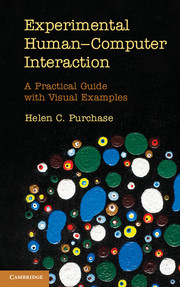Book contents
- Frontmatter
- Contents
- List of experiments
- Acknowledgements
- Preface
- 1 Introduction
- 2 Defining the research
- 3 Experimental procedure
- 4 Data collection and qualitative analysis
- 5 Statistics
- 6 Reporting
- 7 Problems and pitfalls
- 8 Six principles for conducting experiments
- Appendix A1 Independent measures examples
- Appendix A2 Statistical formulae
- Appendix A3 Factor analysis example
- Bibliography
- References
- Index
4 - Data collection and qualitative analysis
Published online by Cambridge University Press: 05 August 2012
- Frontmatter
- Contents
- List of experiments
- Acknowledgements
- Preface
- 1 Introduction
- 2 Defining the research
- 3 Experimental procedure
- 4 Data collection and qualitative analysis
- 5 Statistics
- 6 Reporting
- 7 Problems and pitfalls
- 8 Six principles for conducting experiments
- Appendix A1 Independent measures examples
- Appendix A2 Statistical formulae
- Appendix A3 Factor analysis example
- Bibliography
- References
- Index
Summary
Designing an experiment is more than creating stimuli and tasks and deciding onthe participant experience. Before conducting the experiment, the exact form ofdata to be collected needs to be decided, and importantly, it needs to beconfirmed as sufficient for answering the research question.
This chapter focusses primarily on data collection. It describes the differenttypes of data that can be collected for different purposes and the means ofcollecting it.
We make the traditional distinction between quantitative data(represented by numbers; e.g., the number of errors, a preference ranking) andqualitative data (not represented by numbers; e.g., averbal description of problems encountered in performing the task, a videoshowing interaction with an interface).
In practise, there are two distinct decisions to be made about data:
What data to collect (a decision made in advance of the experiment),and
How to analyse the data (a decision made after the experiment hasbeen run).
These two decisions are inextricably linked because the potential means ofanalysis will influence the decision on what data to collect. Any discussionabout data collection therefore necessarily entails discussion on how it will beanalysed.
Information
- Type
- Chapter
- Information
- Experimental Human-Computer InteractionA Practical Guide with Visual Examples, pp. 95 - 115Publisher: Cambridge University PressPrint publication year: 2012
